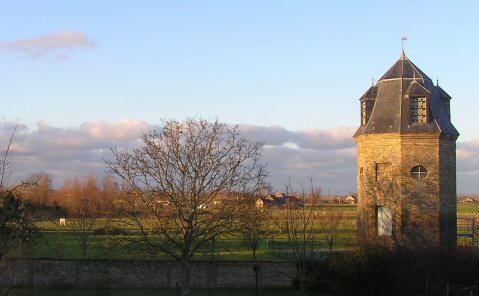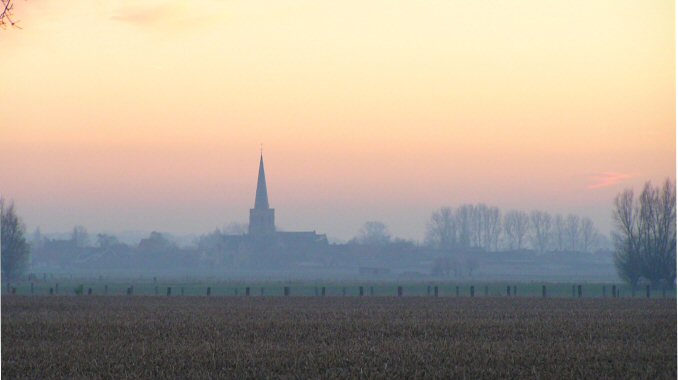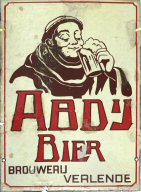 Secret History of De Oude
Abdij
Secret History of De Oude
Abdij
|
The answer is to make for the Oude Abdij Hotel in Lo, West Flanders, where you can enjoy good food, drink and history without even leaving the premises! |
|
| As you approach the Oude Abdij
Hotel down its impressive tree-lined drive, you are looking at the brewer's
house of a former brewery. Keep going straight towards the main
building and as you get closer to the old front door, look to your right at
what |
 |
| Going back much further into the history of Lo, we find it was an abbey town. Monks of the Augustinian order were there in the 11th century. Through gifts from noble patrons they came to own about 500 hectares of land and buildings, and you can be sure that they would have been brewing for themselves and their guests. However the abbey subsequently suffered considerable damage in Protestant riots during the revolt of what was then known as the 'Low Countries' against their Catholic Hapsburg rulers. Subsequently, when the area came under the rule of the Spanish Empire, the fortunes of the monks were restored and they were able to build a surprise gift to greet abbot Patricius Fraeys on his return from Rome in 1710 - an octagonal dove cote in the form of a substantial tower holding 1132 nest boxes. You can still see it, built into the wall surrounding the Oude Abdij Hotel - and go inside if you wish. |  |
 |
During the French Revolution, when the French took the Low Countries, the monks were persecuted and the abbey was abandoned and subsequently ransacked. When the parishes were eventually restored, the church of the former St. Pieter's abbey was entrusted to a village priest, while such abbey buildings as remained were sold off. One renovated dwelling in the former abbey complex was bought by the Verlende family in 1848 and this was to become the St. Louis mouterij-brouwerij (malt house and brewery). |
| Today you would normally go into the Oude Abdij
Hotel through the double glass doors in the modern extension which
houses the reception desk. But the original front door is still
there to the right, leading into the marble floored hallway which you will
find just beyond the bar. In the interests of history, tear yourself
away from the bar, go into that hallway, and look at the superb stained
glass window above the door. (Just in case you can't bring yourself to
leave the bar, here's a picture of the window!) This symbol of the
former brewery is Saint Louis, King Louis IX of France who lived 1214-1270
and was canonised in 1297. As well as being a popular Now look again at the anchor on the wall there - what looks like a crooked fluke crossing it, is actually a representation of a |
|
| In the19th century the town of
Lo had 1500 inhabitants - and 4 breweries within the town! The
proportion of one brewery per 500-600 people was not unusual for those days,
but Lo was particularly fortunate! In 1858 the average yearly
production for the St. Louis brewery was 713 hectolitres or 15,683 Imperial
gallons; assuming a quarter of the
inhabitants (375) supported this brewery there would have been 334 pints (or
190 litres) for every man woman and child! (By comparison, in 2004, the UK annual beer consumption was only 99 litres per head and 21st century Belgians could only manage a miserable 93 litres each!) By the mid-1930s the site looked very different - the brewery and laboratory were where the present garage stands, the main part of the building held the malt house, and in the open space to the left and at right angles to today's building stood a whole range of buildings including a machine shop as well as the beer storage cellars, the whole being dwarfed by tall grain silos behind them. |
|
| After a recession
in World War Two the brewery made a comeback in the post-war years, with new
equipment being installed. But later increasing competition from the
large brewing companies and decline in the malting business forced the
family to call a halt to brewing and malting operations. The site
continued for a while as a beer warehouse for three other out-of-town
breweries but in 1966 the operational buildings were knocked down and
cleared. A restaurant was set up in the old brewer's house and later
it became the Hotel that we know and love today. For more information on the history of the Verlende family and their brewery, see 'De bierslag van Zannekin', by Chris Vandewalle, published by de Snoek. Copies are also available from reception at de Oude Abdij. Beer consumption per capita is taken from Wikipedia. |
|
 Oude Abdij Hotel, ordering a tasty glass of St. Bernardus 8 or a hoppy
Hommelbier, just glance up to your left where you can still see the old
monk in the advert cheerfully presiding over the 21st century drinkers,
and raise your glass in a silent toast to the memory of the old St. Louis
brewery.
Oude Abdij Hotel, ordering a tasty glass of St. Bernardus 8 or a hoppy
Hommelbier, just glance up to your left where you can still see the old
monk in the advert cheerfully presiding over the 21st century drinkers,
and raise your glass in a silent toast to the memory of the old St. Louis
brewery.